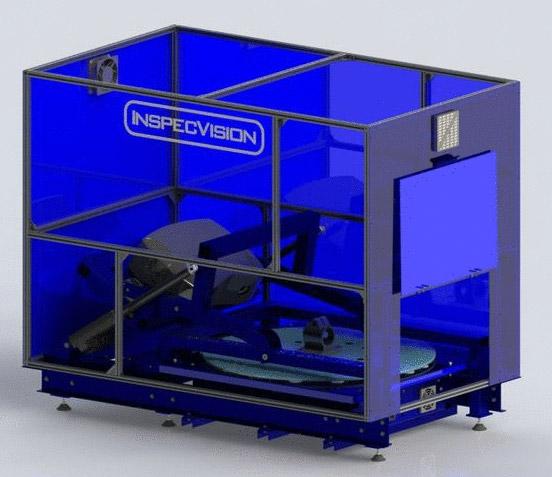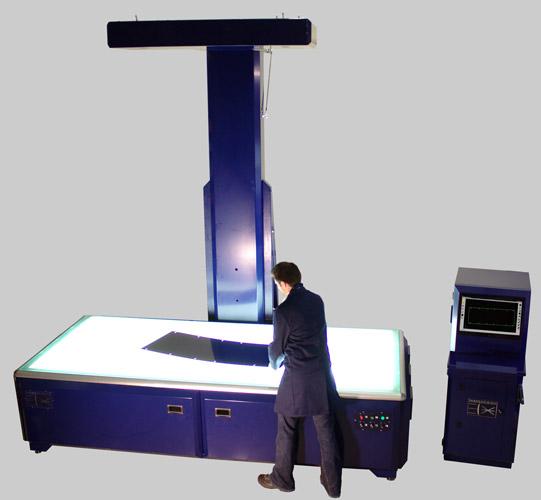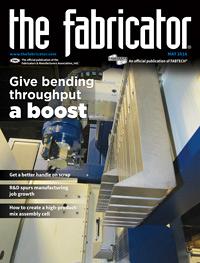Managing Director
- FMA
- The Fabricator
- FABTECH
- Canadian Metalworking
Categories
- Additive Manufacturing
- Aluminum Welding
- Arc Welding
- Assembly and Joining
- Automation and Robotics
- Bending and Forming
- Consumables
- Cutting and Weld Prep
- Electric Vehicles
- En Español
- Finishing
- Hydroforming
- Laser Cutting
- Laser Welding
- Machining
- Manufacturing Software
- Materials Handling
- Metals/Materials
- Oxyfuel Cutting
- Plasma Cutting
- Power Tools
- Punching and Other Holemaking
- Roll Forming
- Safety
- Sawing
- Shearing
- Shop Management
- Testing and Measuring
- Tube and Pipe Fabrication
- Tube and Pipe Production
- Waterjet Cutting
Industry Directory
Webcasts
Podcasts
FAB 40
Advertise
Subscribe
Account Login
Search
Moving beyond the traditional coordinate measuring machine
A purely optical-based measuring system clears up some of the inefficiencies associated with mechanical measurement
- By Dr. Jan Antonis
- May 12, 2016
- Article
- Shop Management

Figure 1
A part like this must be rotated in front of the optical
scanner, or the scanner must be moved to capture all
of the part.
After having worked with a coordinate measuring machine (CMM), have you ever wondered what it would be like if you didn’t actually have to work with an arm, positioning it precisely into place? You might not have to wonder any longer.
Coordinate measuring technology that is based purely on optical viewing is now possible. The sensor technology is powerful enough to scan the entire part without the need to move a scanning head. No precision moving parts means no calibration, single-click scanning, and simplified operation when compared to traditional CMM technology.
To get a better understanding of what this technology might do for fabricators, it’s important to review the evolution of coordinate measuring.
Mechanical and Hybrid Systems
Before the advent of digital cameras or when the cameras had an unusably low resolution, manufacturers relied on contact measurement. Some shops still use this technology to capture measurements. These contact systems typically use complex moving mechanisms to guide or locate a touch probe. While these systems can be extremely accurate, they do have some limitations:
- The operator must guide the system to the appropriate feature, or the shop has to construct a jig for the part and teach the system how to measure the part.
- The operator has to be skilled in programming the machine.
- They typically acquire about one measurement per second. (While it may be possible to use them in scanning mode, they are still orders of magnitude slower than noncontact sensors.)
- They cannot automatically determine when they need to be calibrated.
- Because they can inspect only what they are programmed to inspect, extra or missing features almost never are detected.
Digital cameras with usable resolution made noncontact scanning a possibility. The resolution of these sensors still is not sufficient to cover the entire volume of many parts, so an operator has to move the scanning head over the part. As a result, the scanning head and the mechanical system driving the unit heavily influence the accuracy of these hybrid systems.
Such hybrid systems definitely obtain measurements more quickly than traditional mechanical CMMs, but they still require a skilled and engaged operator to get the most out of the operation.
An Optical Answer
The resolutions of scanner/camera technology today are high enough that it is possible to scan significant volume to an acceptable accuracy and resolution without relying on complex mechanical means to move the scanning head or part. (If all of the features a shop needs to measure cannot be seen from a single viewpoint, movement of the scanning head may be necessary.)
But what resolution do we need to achieve this? One way to assess it is to assume that it is redundant to create a scanner that is much more accurate than the expansion of a part in a temperature-controlled room. For example, a 1.5-m-long mild steel part with a thermal expansion of 13 microns per meter per degree Centigrade, which has been placed in a standard temperature-controlled room (±1 degree C, or a range of 2 C), will change in size by 2 C x 13 µm x 1.5 m = 39 µm.
It would seem pointless to create a scanner that is ±3 µm when the part is changing in size by 39 µm from one minute to the next due to thermal expansion, despite being stored in a temperature-controlled room.
At this point, it is prudent to include a safety factor of 2 in these calculations.

Figure 2
This optical measuring system has a scanning volume
of only 350 mm, but it has an accuracy of 10 microns.
Another important variable is subpixel resolution. Most digital cameras are either gray-scale or color. So rather than containing binary black and white pixels, they contain gray-level information ranging from black to white. Color cameras use Bayer grids and color interpolation to achieve color pixels. Either way, the level of luminosity in the pixel can be used to determine the position of a feature to subpixel resolution. A typical value for subpixel accuracy is 0.1 pixels.
With this information, a shop can calculate the required width of the scanner image in pixels.
The required accuracy is 39 µm
(Thermal expansion in temperature-controlled room)/2 (Safety factor) = 19.5 µm
1.5 million µm (Part length) x 0.1 (Subpixel resolution)/19.5 µm
(Required accuracy) = 7,692 pixels wide
Many cameras have an aspect ratio of 1.5, which means that the image height is 7,692 / 1.5 = 5,128 pixels high
Multiplying the pixel height by width (7,692 x 5,128) results in 39 megapixels.
Cameras on the market today achieve this and even higher resolution. This makes purely optical coordinate measuring a possibility.
A New Way of Measuring
What might some of these purely optical measurement systems look like? Here are a couple of examples.
An Optical CMM. White light scanners project sequences of light onto the part. The part deforms the structure of the pattern, and the camera captures the image (see Figure 1). The advantage of a white light scanner is that it can acquire a measurement at every pixel in the camera.
Because the scanner cannot see all of the part from a single viewing position, the part must either be rotated or moved in front of the scanner, or vice versa. For most parts, a simple solution to this problem is to use a rotational table and tilting axis. Such a setup provides a complete viewing hemisphere. The accuracy and resolution of such a system are limited only by the resolution of the optical devices.
An optical CMM (see Figure 2) works with a single click after the part is put on a table; after the click, the scan and inspection commences. Because the system measures every visible surface every time it scans the part, it is likely to detect miniscule and extra features. In addition, because the optical CMM produces a measurement at every pixel in the camera, it can process the highly ordered data much more easily than the disordered point clouds from laser scanners mounted on traditional CMM devices.
Many systems like this can detect automatically when they need to be calibrated. For example, if the camera suffers trauma and needs to be calibrated, the system detects this and provides an indication that this mechanical deficiency needs to be addressed.
2-D Inspection. This technology is not limited to use on just 3-D parts. The inspection of 2-D parts is best achieved with a 2-D scanner using this optical capability, rather than a 3-D optical scanner.
In one example of a machine with a 3-m-wide measuring bed (see Figure 3), the device’s two 37-MP cameras can acquire up to 80 million measurements in less than 0.1 second.
Again, the advantages of this optical measuring machine are similar to those of 3-D equipment. It is fast and automated, requires no programming, requires no jigging, provides robust inspection, and automatically signals when calibration is necessary.
Large-volume Scanning. One of the really interesting advances in optical systems is the field of photogrammetry, particularly texture-based photogrammetry.
Until recently photogrammetry systems involved attaching optical markers to an object to create unique optical features. The operator would simply take pictures of these markers from different positions, and the software would identify these unique features, matching them in each of the images. This correspondence information then could be used to calculate the marker positions, the camera, and sometimes the camera’s calibration parameters.
New advances in optical feature detection eliminate the need to attach markers to an object, as long as the object possesses a textured surface, such as bricks or rust. These surface textures can be used as features and located in multiple images to allow calculation of surface measurement points.
Systems like this are extremely flexible, to the point where the same system can be used to measure objects the size of a thimble or a planet (see Figure 4).

Figure 4
Advances in photogrammetry mean that an optical scanning of a mountainous surface can translate into a 3-D map of the mountain. Affixing strategically placed markers on the mountain surface and taking pictures of those markers to help create a database that can be used to create a 3-D map is no longer necessary.
About the Author
subscribe now

The Fabricator is North America's leading magazine for the metal forming and fabricating industry. The magazine delivers the news, technical articles, and case histories that enable fabricators to do their jobs more efficiently. The Fabricator has served the industry since 1970.
start your free subscription- Stay connected from anywhere

Easily access valuable industry resources now with full access to the digital edition of The Fabricator.

Easily access valuable industry resources now with full access to the digital edition of The Welder.

Easily access valuable industry resources now with full access to the digital edition of The Tube and Pipe Journal.
- Podcasting
- Podcast:
- The Fabricator Podcast
- Published:
- 04/16/2024
- Running Time:
- 63:29
In this episode of The Fabricator Podcast, Caleb Chamberlain, co-founder and CEO of OSH Cut, discusses his company’s...
- Trending Articles
AI, machine learning, and the future of metal fabrication

Employee ownership: The best way to ensure engagement

Steel industry reacts to Nucor’s new weekly published HRC price

Dynamic Metal blossoms with each passing year

Metal fabrication management: A guide for new supervisors

- Industry Events
16th Annual Safety Conference
- April 30 - May 1, 2024
- Elgin,
Pipe and Tube Conference
- May 21 - 22, 2024
- Omaha, NE
World-Class Roll Forming Workshop
- June 5 - 6, 2024
- Louisville, KY
Advanced Laser Application Workshop
- June 25 - 27, 2024
- Novi, MI



























